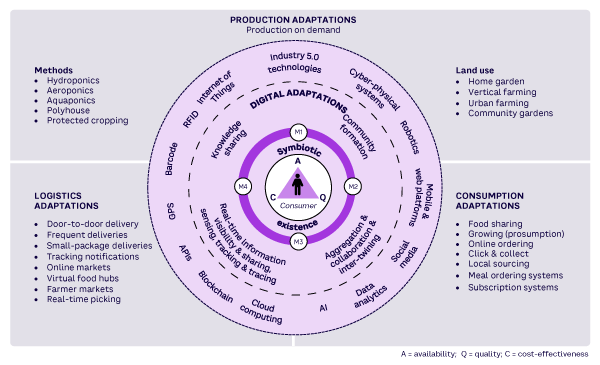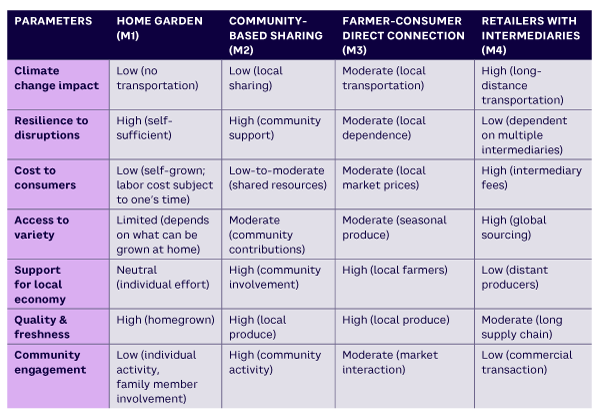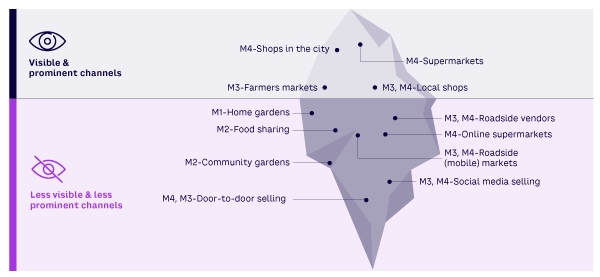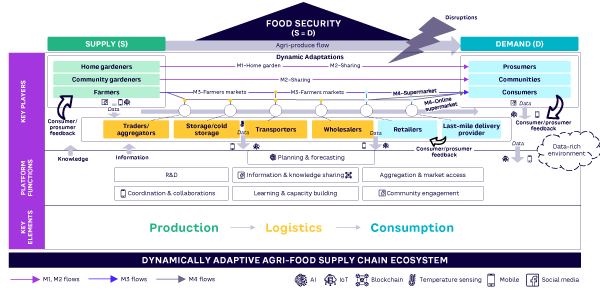AMPLIFY VOL. 37, NO. 7

Climate change, driven primarily by greenhouse gases (GHGs) such as carbon dioxide (CO2), presents a significant threat to global food security by causing extreme weather events like droughts, floods, and heat waves.1 These events could negatively impact agri-food supply chains (ASCs) by disrupting food production, logistics, and consumption, which could threaten food security for people.
Changes in temperature and rainfall directly reduce the amount of food produced, affecting food availability. Larger-scale disruptions to transportation routes can cause delays and increase costs, leading to food shortages or significant price increases. The unpredictability of these events complicates planning for farmers, affecting planting and harvesting schedules and resulting in inefficiencies, losses, and food waste.
Disruptions to ASCs vary greatly by region, influenced by local conditions that impact production, logistics, and consumption. For example, Singapore’s approach to food insecurity during the pandemic differed from Australia’s or India’s. Food security requires a consistent, ample flow of food into food systems to feed populations worldwide, so ASCs must be prepared to address future challenges at both regional and global levels.
How can we prepare for climate change impacts on ASCs? One of the most relevant sources is the COVID-19 pandemic response, which provides unique insights into managing widespread disruptions. By studying the effective adaptations observed during pandemic disruptions, we identify how supply chains can be reconfigurable and responsive to various production, logistics, and consumption challenges. This involves establishing strategies that help adapt to diverse conditions while mitigating CO2 emissions, ensuring viability in food supply chains amidst evolving climate uncertainties. Emphasizing the integration of digital innovations and sustainable practices, we present a compelling case for a proactive and flexible approach to securing food production and logistics for the future.
Lessons Learned from the Pandemic
The pandemic exposed significant vulnerabilities in ASCs, highlighting the need for resilience and adaptability. A supply chain with the ability to adapt and survive a long-term disruption is called a “viable supply chain.”2 In this case, “viability” goes beyond measuring a company’s capability to recover from disruptions; it involves ensuring that both supply chains and their ecosystems can survive short- and long-term crises.3
Lessons learned from the pandemic response include strategies to mitigate the impact of climate change on agri-food systems.4,5 The pandemic disrupted agri-food systems, but no one died of starvation, implying that the systems adapted enough to meet consumer demand for food. Figure 1 shows how consumers around the world secured their food needs during the pandemic and presents a framework for a variety of adaptations observed globally.6
The global context was captured through literature; the local context considered was Sri Lanka. Production (activities from cultivation to harvesting), logistics (collection from farmers, processing, storage, and transport to a location where consumers can access food), and consumption (purchasing from retailers, including last-mile deliveries and final consumption) adaptations emerged and gave consumers access to multiple channels, supported by governments and new/existing technology.

Production Adaptations
Governments in Sri Lanka, the Philippines, and Fiji launched home-gardening campaigns to promote local food production and reduce dependence on external supply chains. Highly urbanized countries such as Singapore promoted vertical farming using hydroponics, aeroponics, and aquaponics, increasing food production in urban areas to reduce import dependence.7 Digital platforms provided farming knowledge and created farming communities on social media. This empowered consumers to engage in farming activities, making them “prosumers” and helping them share knowledge.
Logistics Adaptations
Food hubs and farmer’s markets managed the aggregation, marketing, and distribution of local food products, ensuring continuity in the food supply and supporting local producers. Virtual food hubs connected local producers with consumers through online platforms offering door-to-door deliveries to expand market reach.
Consumer Adaptations
Consumers grew their own food and shared it with their communities, shifted purchasing to local farmer’s markets, used digital tools to order online, and formed communities to share information on food availability and home gardening. Retailers expanded their online presence, offering click-and-collect services and last-mile deliveries to increase food availability.
Types of Agri-Food Supply Channels
Existing ASC channels can be categorized into four primary modes (M1 to M4 in dark purple circle of Figure 1). A channel refers to the specific route or pathway through which goods move from producer to consumer. This includes all steps, processes, and entities involved in the transfer and delivery of the product:
-
M1: Home gardening. Consumers grow fresh agri-produce for self-consumption, acting as both producers and consumers (prosumers). This model emphasizes self-sufficiency and minimal reliance on external supply chains.
-
M2: Community-based sharing. Consumers either individually or collectively grow fresh produce and share it within their community. This model fosters a sense of community and collective self-sufficiency.
-
M3: Farmer’s markets and local shops. Consumers buy fresh produce directly from local farmers. This model supports local economies and reduces the carbon footprint associated with long-distance transportation.
-
M4: Purchasing from retailers with intermediaries. Consumers purchase fresh produce grown by distant farmers and handled by various intermediaries, such as wholesalers and supermarkets. This model offers convenience and variety.
Table 1 compares these four categories based on impact of climate change, resilience to disruptions, cost to consumers, access to variety, support for the local economy, quality and freshness of the produce, and community engagement.

Digital Adaptations
Innovative technologies enable the above adaptations. When the logistics from conventional production locations to consumer demand locations were disrupted, the production locations changed, and logistics and consumption processes were reorganized accordingly. That provided visibility into smaller-scale production, logistics, and consumption methods.
Consumer-Centeredness
Digital technologies played a key role in enabling adaptations by diverting the information flow toward the consumer, empowering this group to make decisions. It allowed consumers to access these channels both physically and digitally, maximizing their desire for cost-effectiveness (C), quality (Q), and availability (A) of food, indicated by the middle triangle in Figure 1.8
Symbiotic Existence
There is an interdependence among M1, M2, M3, and M4, in which the surplus from one channel can be used to support another, benefiting both parties.9 This dynamic, interconnected ecosystem mirrors natural symbiotic relationships and enables innovative business models (e.g., such as service-driven farming) to thrive in a post-industrial era. Thus, digital innovations blur traditional boundaries between production, logistics, and consumption, fostering a viable ASC.
Case Study: Sri Lanka
Our study revealed that Sri Lanka’s geographical diversity (variations in land availability, infrastructure, and population density across rural, urban, and semi-urban areas) has significantly shaped adaptations in the ASCs due to disruption to key activities in production, logistics, and consumption. These geographical factors influenced the ability of different regions to produce, distribute, and consume food during the pandemic (see Table 2).

Figure 2 depicts the agri-food system in Sri Lanka. It shows agri-food flows from producers to consumers in different regions, subject to the key factors identified in Table 2. The overarching goal is to make food available for the entire population in Sri Lanka, regardless of regional divides. Figure 2 also shows the flows of food via M1 to M4 channels, where M1, M2, and M3 channels form short food supply chains (SFSCs), while M4 forms long food supply chains (LFSCs).10,11 Below are the key insights gained.

Rural Resilience & Self-Sufficiency
Rural areas, abundant in agricultural land, produce significant agri-food that also supplies urban and semi-urban populations. Pandemic lockdowns disrupted this supply, causing food insecurity in urban areas while rural areas had a surplus. Adaptations in ASCs showed that traditional M3 and M4 channels became less accessible, leading to a rise in home gardening (M1). Although minimal before the pandemic, production-for-self (M1) grew significantly during the disruption, especially in rural and semi-urban areas, with some urban populations also starting gardens in their limited spaces. This shift increased resilience and self-sufficiency in rural areas.
Government Support for Home Gardens
The government of Sri Lanka launched a program called “Saubhagya Gewatta” (which translates to “prosperous home garden”) to create 1 million home gardens in the country. Due to land availability limitations, urban populations generally did not garden. Semi-urban populations practiced home gardening moderately, and most of the rural population had a home garden, making them more self-sufficient.
Government Support to Transport Food
Although home gardening and local sharing increased, this couldn’t meet demand in densely populated areas. The stricter lockdown rules in urban areas prevented food from rural areas from reaching urban markets, resulting in food shortages. With fresh food shortages, reliance on dry food grew. To address this, the government issued special permits to truck owners, enhancing the flow of food from rural to urban and semi-urban regions. Small trucks began door-to-door deliveries, and roadside sales became a common sight. Wholesalers from rural economic centers noted a shift during the pandemic: traditional urban vendors from urban areas were replaced by new players that obtained government permits to purchase and transport food.
The country also faced a fuel shortage, leading to forming queues at fuel stations. To help prevent food supply disruptions, the government issued special permits prioritizing fuel purchases for food transporters. This ensured an uninterrupted food supply across all regions, allowing the urban population to access fresh food and demonstrating the effectiveness of government intervention in maintaining food supply continuity.
Sharing Knowledge & Creating Communities to Ensure Food Availability
Consumers in urban and semi-urban areas used digital tools to learn about gardening and share their experiences on social media. They also used these platforms to sell or share excess produce. During the pandemic and the subsequent economic crisis, use of the Govinena Home Garden mobile application increased significantly, highlighting its importance.12
Retailers Adopting Online Platforms to Make Food More Available
Urban areas with high population densities faced significant logistics disruptions, and online supermarkets became crucial in supplying fresh produce (M4U channels). Initially unable to meet demand, key supermarkets saw a surge in online orders as technology became more accessible. They adopted multiple methods, including phone calls and WhatsApp, to accept consumer orders.
Businesses with existing technology infrastructure for other industries developed e-commerce platforms and social media pages to sell fresh produce (repurposing) and expanded their portfolios (scalability). They developed innovative delivery methods by collaborating with other businesses (intertwining), including delivery services that previously specialized in perishables like meals and flowers (repurposing).13
Our case study shows that although supply chains were disrupted due to the pandemic, they quickly started reorganizing and creating new supply channels, making connections between food supply and demand subject to various local conditions. This was enabled by the government, businesses, communities, and digital technologies.
Creating ASC Ecosystems
The metaphor of an iceberg is often used to describe situations where the visible part of an issue or phenomenon is a small portion of the whole (see Figure 3). In this situation, the tip of the iceberg represents the conventional, large-scale ASCs most people are familiar with, such as supermarkets, box stores, and large farmer’s markets.

The larger part of the iceberg (submerged) represents the smaller channels that came about or became more prominent during the pandemic. These include local farmer’s markets, community gardens, home gardens, food sharing, online channels, and door-to-door sales. These channels are less visible to the public but played a vital role in ensuring food security during the pandemic. They provided an alternative (and often more resilient) source of food, especially when larger supply chains were disrupted due to lockdowns, logistics failures, and labor shortages. They also have the advantage of promoting local economies, reducing food miles, and providing fresher food.
Digital Environment for Dynamically Adaptive ASCs
As shown in Figure 3, food supply methods can change based on varying conditions, allowing consumers to access multiple sources depending on their situation. When conditions change, certain methods move below the surface, and less popular methods come to the surface — provided diversity is present.
Diversity helps ASCs connect to changing conditions. That is why different regions of the country were subjected to different sets of conditions, and the adaptations happened differently. Figure 4 shows how supply chain structures can be dynamically reconfigurable in digital environments.14 The components in green, purple, and blue represent production, logistics, and consumption, respectively. The overarching objective is to achieve food security, ensuring equitable access to sufficient, nutritious food at all times.

Environmental disruptions can disrupt this equilibrium, making established supply chains vulnerable. The seamless connection between producers (farmers) and consumers is at the core of the supply chain’s function, effectively aligning supply with demand. Additional components and entities (e.g., intermediaries, logistics service providers, technologies) are strategically organized to support this fundamental activity, optimizing each one’s operational efficiency.
Digital interconnectivity among supply chain entities enables rapid reconfiguration. These technologies capture data across supply chains, creating a data-rich environment that facilitates the smooth movement of food from surplus areas to regions experiencing high demand. Simultaneously, consumers evolve into prosumers as they engage in both production and consumption.
Our research shows that consumers now have increased access to farming knowledge and market information, enhancing purchasing decisions and enabling active participation as prosumers through digital technologies. Social media and various knowledge platforms are the primary channels for disseminating this information.
This process necessitates the development of new business models responsive to changing conditions. Platforms that facilitate sharing and implementation of R&D are essential, as are robust systems for planning, forecasting, coordinating, aggregating, and collaborating.
Consumer feedback is crucial to this adaptive process, providing important insights into demand fluctuations, preferences, and satisfaction levels, enabling supply chain actors to adjust and optimize operations in real time. This iterative process ensures the ASC ecosystem remains responsive and resilient in dynamic environmental and market conditions.
Conclusion & Recommendations
Due to the unpredictable nature of climate change events, it’s crucial to transition from short-term resilience to sustained survivability (viability) of supply chains and their ecosystems during prolonged crises. Key strategies include diversifying food supply methods with various channels and enabling digital interconnectivity. Local food supply chains, home gardening, and community gardens are essential for bolstering food security during crises, and farming practices such as vertical farming and hydroponics are vital for sustainable production on limited land. Innovative transportation and logistics methods are also essential.
Our study suggests a blueprint for dynamically adaptive ASC ecosystems within a digital framework. It involves reconfiguring production, logistics, and consumption methods based on local conditions to address diverse challenges while reducing CO2 emissions. Integrating advanced technologies with sustainable practices and community engagement forms the foundation for a resilient, viable, and adaptive ASC ecosystem. Achieving these goals requires collaborative efforts from diverse stakeholders, including government bodies, businesses, farmers, technology providers, and local communities. This comprehensive approach secures long-term sustainability and efficiency in food production and distribution, ensuring food supply continuity amidst climate change and other global disruptions.
Acknowledgments
We sincerely thank all participants who shared their experiences and insights as consumers, retailers (including vegetable shops, supermarkets, and farmer markets), wholesalers, transport providers, agri-tech entrepreneurs, and agriculture policymakers in Sri Lanka. We also extend our deepest gratitude to Western Sydney University, Australia, for funding and supporting this PhD research project.
References
1 Kogo, Benjamin Kipkemboi, Lalit Kumar, and Richard Koech. “Climate Change and Variability in Kenya: A Review of Impacts on Agriculture and Food Security.” Environment, Development and Sustainability, Vol. 23, January 2020.
2 Ivanov, Dmitry. “Viable Supply Chain Model: Integrating Agility, Resilience and Sustainability Perspectives — Lessons from and Thinking Beyond the COVID-19 Pandemic.” Annals of Operations Research, Vol. 319, May 2020.
3 Ivanov, Dmitry, et al. “Toward Supply Chain Viability Theory: From Lessons Learned Through COVID-19 Pandemic to Viable Ecosystems.” International Journal of Production Research, Vol. 61, No. 8, March 2023.
4 Ivanov et al. (see 3).
5 Balezentis, Tomas, et al. “Measures for the Viable Agri-Food Supply Chains: A Multi-Criteria Approach.” Journal of Business Research, Vol. 155, Part A, January 2023.
6 Vidanagamachchi, Kasuni, and Athula Ginige. “Consumer-Centred Viable Agri-Food Supply Chain Ecosystem and Potential Digital Enhancements: An Exploratory Study.” Proceedings of the Australasian Conference on Information Systems (ACIS) 2023. Association for Information Systems (AIS), December 2023.
7 Naskali, A. Teoman, Ozgun Pinarer, and A. Cagri Tolga. “Vertical Farming: Under Climate Change Effect.” In Environment and Climate-Smart Food Production, edited by Charis M. Galanakis. Springer, 2022.
8 Vidanagamachchi and Ginige (see 6).
9 Vidanagamachchi and Ginige (see 6).
10 SFSCs are systems in which the production and consumption of food are closely linked in terms of geography, social context, and economy. They aim to minimize the distance and number of intermediaries between producers and consumers. Benefits include supporting local economies, enhancing transparency, improving food quality, and potentially reducing environmental impacts; see: Marsden, Terry, Jo Banks, and Gillian Bristow. “Food Supply Chain Approaches: Exploring Their Role in Rural Development.” Sociologia Ruralis, Vol. 40, No. 4, December 2002.
11 LFSCs involve multiple intermediaries and cover extensive geographic distances. They feature complex logistics, including multiple stages (e.g., processing, packaging, warehousing, and transportation), often across regions or countries. This complexity can affect traceability and have an environmental impact due to extended transportation; see: Ilbery, Brian, and Damian Maye. “Food Supply Chains and Sustainability: Evidence from Specialist Food Producers in the Scottish/English Borders.” Land Use Policy, Vol. 22, No. 4, October 2005.
12 Vidanagamachchi and Ginige (see 6).
13 Intertwining, substitution, scalability, and repurposing are the four generalized adaptation strategies for viable supply chains; see: Ivanov, Dmitry. “Supply Chain Viability and the COVID-19 Pandemic: A Conceptual and Formal Generalisation of Four Major Adaptation Strategies.” International Journal of Production Research, Vol. 59, No. 12, March 2021.
14 Vidanagamachchi and Ginige (see 6).





